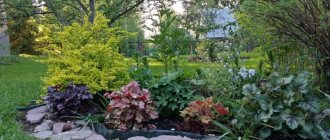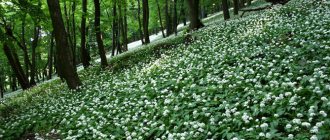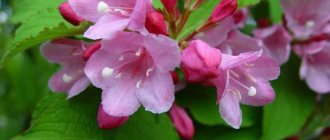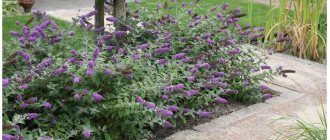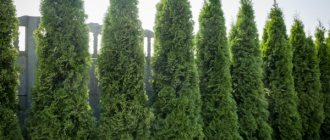Description of rhododendron
Rhododendron belongs to the heather family, which includes evergreen plants, shrubs and trees that completely or partially lose their leaves at certain times of the year. The most famous and widespread are azaleas grown indoors, in greenhouses and greenhouses.
It grows in the subtropics and temperate zone of the Northern Hemisphere, although it is also found in the Southern Hemisphere. There are 18 known species in Russia, which are distributed in the Caucasus, Siberia and the Far East. They grow singly or in groups forming entire thickets, in the mountains or under trees in the forest, in swampy areas or in the tundra. The place should be shaded and moist, but water should not stagnate in the soil. There is dampness in the air.
Types of rhododendron vary in height (from 10-20 cm to 30 m) and in flower size (several mm and more than 20 cm). Simple and compound leaves with different edges. Bisexual flowers with a corolla of different colors: lemon, pink or purple-violet. They are combined into simple and complex inflorescences, and are extremely rare alone. The fruit is represented by a five-leaf capsule that opens downwards. The seed resembles a stick 0.5-2 mm. Numerous small roots are located on the surface. Characterized by slow growth. Can be propagated in various ways.
Rhododendron is a poisonous plant containing andromedotoxin. This substance first has an stimulating effect, and then a depressant effect, leading to death. Tannins are present in the bark and leaves.
What is a garden azalea?
Most garden varieties of rhododendron are shrubs of various shapes. The root system of plants is formed quite compactly and is located quite close to the surface, which makes it possible to transplant a flower from flowerbed to flowerbed without much difficulty.
The rhododendron plant, photos of which are presented in the review, may have petiolate or sessile leaves, located alternately on the shoots. The shape of the leaves is serrate or with a solid edge, obovate or egg-shaped. The color of the inflorescences can also be very diverse - lilac, violet, red, white.
As a rule, rhododendron flowers are collected in brushes or corymbs. Their shape directly depends on the subspecies and variety. She may be:
- funnel-shaped;
- campanulate;
- wheel-shaped;
- tubular
It should also be noted that individual varieties of rhododendron differ in aroma. Some smell very sweet and sharp, others are gentle and soft.
Some varieties of indoor rhododendron flowers can produce fruits in the form of a five-leaf box containing two-millimeter stick seeds. The root system is quite compact, consisting of a huge number of fibrous roots intertwined with each other.
In nature, the flower can occur as a single plant or grow in a group, forming impenetrable thickets with sufficient moisture and in shady places.
Types and varieties of rhododendron
Typically, shrub varieties are grown in gardening.
| View | Description of the bush | Sheet | Flower |
| Deciduous | |||
| Daursky | Medium with great branching. Early flowering. Steel-colored bark, thin reddish-brown shoots with slight pubescence. | Elongated, green, lemony in autumn. 5 cm | Purple-pink in the shape of a funnel. |
| Kamchatsky | Miniature in the shape of a hemisphere. Dwarf. | Large, ovoid. 5 cm | Bright carmine. Inflorescence of 3 pcs. with a velvety surface. |
| Canadian | Low, compact up to 1 m. Twisty, thin strong branches. | Elliptical, bluish-green. | Pink-lilac. The heavily cut petals resemble a moth. |
| Evergreens | |||
| Caucasian | Creeping shoots up to 1.5 m. Dark brown bark. | Dark green, smooth above and hairy below. | Fragrant, yellow with green specks or white. Bell shape. Brush of 8-12 pcs. |
| Smirnova | Young branches have slight white pubescence, old branches have gray bark. up to 1-2 m. | Oblong-elliptical 8-10 cm. | Purple in the form of a bell. |
| Adams | Branched 0.5 m. Shoots covered with glandular hair. | An elongated ellipse, bare above, with scales below. Ginger. | Various pink shades. Corymbose inflorescences 7-15 pcs. |
| small-leaved | Beautiful, compact. Young branches are rusty in color, old ones are steel. Straight or creeping. 0.5-0.6 m. | Oblong-lanceolate. | Golden 3 cm. |
Application
The scope of use of rosewood, despite its unique qualities, is narrow. Rarity and high cost have long made this material not accessible to everyone. It was used to make piece parquet in palaces and houses of the nobility, parts of musical instruments, furniture elements, interior wall decoration, figurines, carved collectible chess sets, boxes, and jewelry. Artists used rosewood plates as a source material for creating miniatures. It can serve for hundreds of years without deforming, drying out, or succumbing to damage or rotting.
In the modern world, the scope of application of this valuable material can be considered the production of finishing in top-class vehicles: limousine interiors, cabins of yachts and liners. The bodies and necks of expensive guitars are made from rosewood, and the handles of collectible knives are turned.
Despite the enviable strength, moisture resistance and other excellent characteristics necessary in construction, there is, of course, no need to talk about the widespread use of rosewood in it. It’s hard to even imagine how much it would cost to install window frames in a house or lay floors from it. Wood is used as a valuable ornamental material and is a constant indicator of luxury and refined taste for owners of any items made from it.
Taking advantage of the fact that rosewood is a desirable material for collectors and lovers of luxury, swindlers selling wood pass off cheaper species as valuable species: Bolivian rosewood, wenge, masasuba, chechem, culupai and other tropical varieties. A true connoisseur who deals with rosewood in practice can distinguish the imitation from the original. Based only on the structure and color scheme of lumber, you can easily be deceived. Externally, expensive and cheap breeds are similar, but the quality and durability of the latter are noticeably lower.
True rosewood is becoming so rare due to many circumstances that it is found only in shadow markets or in Asian or South American stores in places where the trees grow. In Europe, parquet boards and other rosewood finishing materials are officially prohibited for sale. The danger of extinction of valuable species plays a significant role in this.
Planting rhododendron
In order for rhododendron to grow on a site, it needs to choose a suitable place, prepare the soil and properly plant and care. Deciduous species require a lot of light, while evergreen species require shade. All of them require shelter from the wind, and in winter from snow, so it is better to plant them near buildings, fences or tall plants. Trees that have the same structure of the root system are not suitable as neighbors: birch, spruce, maple and others. They can grow near oak, pine and fruit plants: apple, pear, cherry.
Rhododendrons prefer loose, acidic soil (4.5-5.5 pH), which freely provides access to air and water (does not linger). Sandstone and loams are deoxidized by adding peat, compost, pine needles, and bark.
Bushes at the age of 2-3 years are transplanted into a recess of 30x30 cm, older ones - into a recess of 60x40. A drainage made of crushed brick or large gravel is placed on the bottom, a special mixture of soil, peat, rotten pine needles, sand, compost (humus) is placed on top and it is well moistened so that it settles. The roots of the plant are placed in water and kept in it until the air bubbles disappear. The depth level is 3-4 cm above the root. After planting, the soil is moistened and mulched with a mixture of peat, sand and crushed pine bark.
Evergreen small-leaved variety
All these rhododendrons come from China. In addition to small leaves, their distinctive feature is an annual growth of 1-3 cm and a looser crown. Experts believe that the reason for such differences is the specificity of solar activity in the growing region.
Attractive (Rh. keleticum)
It is not for nothing that this rhododendron received the name attractive. In June it blooms very beautifully for 18 days with large purple-violet flowers. This creeping shrub has a crown with a diameter of only 40 cm, and it reaches a height of 15 cm. It tolerates cold well and survives under snow. This plant is afraid of only one thing - getting wet.
For successful development, attractive rhododendron needs moist, but well-drained, slightly acidic soils. For alpine slides it is a real find
Group of dense rhododendrons (Rh. impeditum)
The name dense rhododendron refers to a whole group of plants that grow into small bushes that resemble a dense pillow. After planting, this shrub comes to its senses and blooms with separate flowers, but, having already settled down in a new place, it pleases its owners with abundant and long-lasting flowering.
This group of plants does not like getting wet, tolerates sunbathing well and has varying winter hardiness, depending on the variety.
Specialists from Germany and the Czech Republic are actively involved in the selection of dense rhododendrons. And the results of their work truly please Russian gardeners
Ornamental blush (Rh. russatum)
The homeland of the blushing rhododendron is Yunnan Province (China). This plant also forms a cushion up to a meter high and 80 cm in diameter. This species is most likely named blushing due to the reddish-brown underside of its lance-shaped leaves.
Rhododendron blushing grows in acidic, moist, but well-drained soils and will take root well in rock gardens and gardens in Russia
The plant blooms in early May with dark purple flowers with a white throat. They are odorless and form spectacular inflorescences of 4-5 flowers each. This slow-growing shrub loves sunlight and tolerates winter cold well.
Rhododendron care
Care for the plant following the rules:
- Water depending on the weather and drying of the soil. At the beginning of development, sufficient moisture with soft water is required: in summer - 1-1.5 buckets per mature plant 4 times a month, in hot weather - more often. When it gets cooler, less often - every 1.5 weeks. Water with acidified water (10-15 g of oxalic or citric acid per 10 l).
- Feed with mineral fertilizers. In the spring to revive the plant and begin its flowering. In the summer, to speed up the growth of shoots and the formation of buds for the next year. In autumn (without nitrogen) - to prepare for winter.
- Prune in the spring, removing dry and diseased shoots. You can shorten those branches that disrupt the shape of the bush. Withered flowers are torn off, otherwise the plant looks sloppy. It is necessary to direct energy to the growth of new branches and flowers.
- Transplanted at any age. It is best before the sap begins to flow - in the spring, later - after flowering or at the very beginning of autumn, so that it has time to get stronger before the beginning of winter.
- A winter-hardy plant, but it is better to cover it during the cold period.
Features of growing in cold climates
Some gardeners, having chosen a beautiful specimen of rhododendron and planted it on a plot in the Moscow region, are disappointed, since the bush does not take root and freezes at the first frost. This is not surprising, since the plant was chosen incorrectly.
There are specimens suitable only for warm regions. Planting just such bushes gives unsuccessful results.
Among rhododendrons there are cold-resistant varieties
Residents of the Leningrad region and Moscow region can grow rhododendron in their garden if they choose the right variety. And then the bush will delight gardeners with its exotic beauty.
Among rhododendrons there are cold-resistant varieties. These are deciduous plants of the following varieties: Phukansky, Kamchatka, Schlippenbach, yellow, Japanese. Of the evergreens, the following are suitable: Cavtenby (hybrids: Nova Zembla, Abraham Lincoln, Alfred, Kenningham), Smirnova (hybrids Laika, Dorothy Swift, Gabriel), the largest, golden, short-fruited.
Northern Light plants are suitable for the cold of central Russia: Spicy Lights, Pink Lights, Rosie Lights. Finnish varieties have recently been developed for harsh climates: Hague, Elvira, Mikkeli.
It is not enough to have a cold-resistant variety; you need to plant it correctly and provide the necessary care.
Having chosen a shady place, you need to prepare a soil mixture by mixing peat with garden soil and pine needles. Rhododendron mixture can be purchased at the store. Complex mineral fertilizer is added to the soil. The bush must be planted while maintaining a distance from other trees, the distance should be at least a meter so that the roots do not interfere with the development of the bush.
If the soil is clayey, a 15 cm layer of broken brick is poured onto the bottom of the pit. The size of the pit should be twice the size of the container with the plant. When planting, it is not recommended to bury the root collar of the bush; it should be flush with the surface of the earth. After compacting the soil, the rhododendron needs to be watered.
Caring for the plant is the same as for a regular garden species.
It is necessary to adhere to certain rules, these are:
- maintain soil acidity at the proper level, avoid alkalization. Avoid getting ash, dolomite, lime into the soil, as these substances alkalize the soil.
- You cannot loosen the soil around the planting , as you can damage the root system located close to the surface of the earth. Mulching is used instead
- plant rhododendron on the northern shady side of the site. Protect the bush from direct sunlight by covering it with cloth or gauze.
- do not flood the plant. In summer, water twice a week.
Constantly falling rains in the fall can cause rapid growth of numerous shoots. Since they die with the onset of cold weather before they have time to ripen, their appearance can be avoided by spraying the bush with potassium monophosphate or sulfate (1.0%). This procedure prevents the development of young shoots and promotes the formation of flower buds.
You cannot water the plant after spraying, even if the weather is dry.
Before the onset of cold weather, the bush is covered with a frame with film and secured with twine to prevent cold air from entering.
Reproduction
There are several methods of propagation: seeds, dividing the bush, layering and cuttings.
The seeds are sown shallowly in a bowl filled with a damp mixture of peat (heather) soil and sand in a 3:1 ratio. For a greenhouse effect, cover with glass or cellophane and place in the light. Aerate, irrigate and remove condensate daily. Shoots will appear in 30 days. Transplant the seedlings into another container after two leaves appear (diagram 2x3 cm). In the garden - for the 2nd year, and before that they are grown in a greenhouse. Flowers will appear at the age of 6-8 years.
A cutting is prepared from a part of the stem (5-8 cm) with unripe wood and leaves. The lower leaves are torn off and dipped in a stimulant solution for half a day. Then they stick it into the soil (peat and sand 3:1), on top - a jar or bag so that the roots grow (1.5-4 months), after which a container with soil is needed (peat and pine needles 2:1). In winter, place it in a room with +8...+12 °C and flooded with light. In spring and summer they are transferred to the garden, to the final site - after 2 years.
The easiest way to propagate is by layering: a flexible branch is bent into a groove (15 cm), secured with wire and covered with soil. The top is tied to a pole. The care is normal. In autumn or spring you can separate it from the main plant and replant it.
Divide the bush into parts, which are planted separately. In a year, young branches will appear and flowering will begin.
Rosewood for men's perfume
Rosewood oil is also considered a strong aphrodisiac and helps with sexual problems. Its aroma intoxicates, stimulates sensuality, elevates. Mainly used to make men's perfume, it helps with impotence and impotence. Women often use this oil, which increases receptivity to affection, to eliminate shyness and temporary detachment from the material world.
Before use, it is recommended to check the aroma of the oil for individual tolerance.
Diseases and pests
Rhododendron is susceptible to attack by certain pests and a number of diseases.
| Pest | Symptoms (on foliage) | Elimination measures (spraying) |
| Rhododendron bug | Small white markings. Below are insect eggs (brown). | Diazinon. |
| Asian garden beetle | The hole is irregularly shaped or only veins remain. | |
| Mealybug | Wrong shape. Death. | Karbofos. Repeatedly. |
| Grooved weevil (fluted weevil) | The edges are damaged, the bark near the root is eaten away. | 0.3% karbofos emulsion, for irrigation 0.2-0.3%. At the end of summer, 0.1-0.15% liquid Bazudin or diazinon and Furadan are used. |
| Spider mite | Below is a thin web. Steel brown color. They fly around. | Agravertine, diazinon. |
| Tillable slug | Through holes appear very quickly. | 0.8% TMTD. Collection of adult specimens. |
| Black thrips | Gray holes on top, dark ones on bottom. Steel tint, shedding. The inflorescence is ugly. Development is slowing down. | 0.2-0.3% nicotine. 0.2% karbofos emulsion. |
| Narrow-winged miner moth | The surface is stained. They curl into a tube, dry out, crumble and crumble. | Spraying or fumigating with sulfur. |
In addition to pests, rhododendrons are susceptible to some diseases.
| Manifestation on leaves / Symptoms | Disease / Causes | Corrective measures |
| Yellowness. Curling, drying out. Flowering is weak. | Mixed chlorosis. There are not enough batteries. Stagnant water, dense soil around the root system or has become alkaline. | Foliar feeding with iron salt of sulfuric acid 7.5 g/l, magnesium 6.5 g/l. |
| Red spots, curling, drying out. | Sulfuric acid salt or ammonium nitrate. Potassium nitrate. | |
| Brownish on top. | Necrosis. Reducing the ambient temperature. | Cover. |
Each case of disease requires identification of the causes and their elimination.
Bush pruning
Many gardeners recommend not focusing on pruning rhododendron, since during the process of growth the plant acquires the correct shape . Only tall bushes and frozen shoots need to be trimmed.
In an adult bush, shoots are pruned in early spring. Garden varnish is applied to sections of thick branches. A month later, when buds appear on the shoots, the plant begins a period of renewal. Very frozen and old bushes must be pruned at a height of 30 cm from the ground surface. First, in the first half of the year, one part of the bush is cut, and in the second half of the year, the other.
The benefits and harms of rhododendron
Rhododendron is used to decorate areas, but it has useful qualities that are used in conventional and folk medicine. The presence of vitamin C, andromedotoxin, ericolin, arbutin and rhododendrin led to its use:
- will help reduce fever and pain;
- will have a calming and bactericidal effect;
- relieve swelling;
- removes excess fluid from the body;
- will lower the pressure.
Contraindications: pregnancy, breastfeeding, kidney disease and tissue necrosis.
It is best to carry out treatment in consultation with a doctor. This will protect you from unwanted consequences or death, which is possible because many species are poisonous.
Rosewood is an excellent antidepressant
This is an excellent antidepressant that relieves lethargy, irritability and fatigue. Having a spiritualizing effect, which not any similar remedy can do, rose oil revitalizes emotions, clears the mind, ennobles the soul and lifts the mood.
Its aroma is the aroma of restoration and relaxation, relieves nervous tension and helps overcome stressful conditions.
How to propagate?
Rhododendron Rosie Lights reproduce well by seeds:
- Sowing takes place in April.
- Seeds should be germinated in a cool room at a temperature of 15 °C.
- Seeds are sown in a sand-peat mixture.
- Moisturizing should be regular.
- The first leaves need to be picked and kept in a greenhouse.
- Seedlings bloom only in the 5th – 6th year of cultivation.
The Rosie Lights variety can also be propagated by cuttings:
- Cuttings are cut 7–9 cm long.
- Leaflets should be left at the top of the cutting.
- Before planting, the cuttings are dipped for a day in a solution with any root growth stimulator.
- The cuttings are planted in a prepared special substrate for rooting.
Feeding rules
First of all, you need to fertilize those plants that you planted recently. The first feeding is done at the beginning of the spring , and the second at the end of the first half of summer, after flowering has ended, and when new shoots are growing. Rhododendrons are ideally suited for feeding with horn meal and cow manure . Cow dung must be filled with water in a ratio of 1:15 and allowed to brew for 2-3 days. After this you can fertilize.
Before fertilizing, the plant must be watered. Do not forget that rhododendron grows in acidic soils, so it is advisable to use fertilizers containing minerals, superphosphate, ammonium and potassium phosphate. These fertilizers must be dissolved in weak proportions, for example 1.1:1000, and if the solution contains potassium substances, then it should be even weaker. It is optimal to fertilize in early spring and mid-summer.





